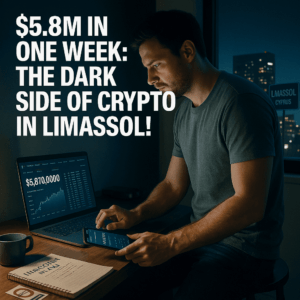Dirty 5,870,000 USDT: An Interview with a Man Who Earns More from Crypto Than He Launders from Black and Gray Schemes
 By: Drew Harlan | Crypto Stories | Published: April 2025
By: Drew Harlan | Crypto Stories | Published: April 2025
Meeting Place: Cyprus, Limassol. A tucked-away corner café where they serve “good frappe with an Irish twist”—the perfect spot for an intriguing conversation.
He slips in quietly, a few minutes late. Classic T-shirt, sneakers, a plain gray jacket. He sits down, orders a double Irish frappe with ice—his English impeccable, laced with a faint London accent. At first glance, he’s just another one of the thousands of IT guys who’ve flocked to Cyprus chasing sun and low taxes. But five minutes in, it’s clear: behind that easy smile lurk schemes wild enough to inspire a Hollywood blockbuster.
“Call me Peter,” he says, his voice steady. “It’s not my real name. But I like it.”
“So, Peter,” I begin. “What do you do?”
He gazes out the window, takes a sip.
“Laundering. Crypto. Since 2021.”
“Just like that? For real?”
“Dead serious. You invited me here for the truth, didn’t you? Here in Cyprus, it’s not a crime. Yet. In the States, though? They might already have a cell waiting for me.” He chuckles, low and dry.
From Designer to “Launderer”
Peter’s a former graphic designer. He cut his teeth in London, then went remote, freelancing for ad agencies across Europe. Millions were never the dream—just stability and, maybe, a Porsche 911 Turbo S.
“I was one of those ‘freelance forever’ types,” he says. “Six hours of sleep, cranking out landing pages and logos, wrestling with deadlines, exchange rates, time zones, payment systems that wouldn’t cough up my cash from overseas gigs. I was always hunting for fixes. Then, in 2020, someone hired me to ‘package’ a crypto project. My first meme coin. That’s when I learned what joy, euphoria, and a thousand regrets are worth.”
“So that’s when you launched your own coin?”
“Not quite. I finished that gig first. Then they came back—second time, third, fourth. By the fourth, I started paying attention, piecing it together. If they’re ordering this stuff from me, someone’s buying into it. I dove into the meme coin market, figured out what crypto really is. I’d heard of it back in 2014, but never dug in. Now? The whole world knows.”
Around the sixth or seventh job, they offered him a gig churning out designs for new projects on a conveyor belt. That’s when the gears started turning. How do they launch so many, so fast? How do they make these coins? Where? Who’s snapping them up? He hit YouTube and started digging.
“Seek and you’ll find,” he says. “All it takes is the drive. The info’s out there, free for the taking.”
Two weeks later, he and two buddies launched their own meme coin. Total cost: $1,700. They threw together a website, paid some micro-influencers for YouTube reviews, whipped up the coin on pump.fun in five minutes—done. Four hours later, it spiked 11x. “Exhilarating,” he calls it.
The next day, their token soared 44x. “Euphoria and adrenaline hit the roof. Less than 24 hours—it was madness! The easiest money I’d ever made. I felt like a god. Like my energy could trigger a global earthquake. It got scary—my emotions spun out of control. Laughing, crying, gasping from my racing heart, punching walls. My body went wild, jerking around chaotically. Three days of that, until I blacked out.”
When he came to, their coin had tanked 40%. A brutal drop—most coins don’t survive that kind of plunge. They often spiral to near-zero, dead forever. The team scrambled: buy up every blogger they could, pump the coin, and unload it on fresh, greedy newcomers. They hired 40-45 crypto influencers—YouTube, X, no haggling, paid whatever was asked.
In a week, they raked in a mind-boggling $5,870,000.
Peter didn’t know how to cash out that kind of crypto haul back then. A friend in the game since 2017 came up with a slick workaround.
The Scheme Begins: Money’s There, Problems Too
“Those funds were ‘dirty,’” he says, “as transparent as the tears of the suckers we dumped our coins on. Anyone peeking at the blockchain could see where the cash came from and roughly where it went. Big problem.”
The crew studied how the pros dodge tracking. They stumbled on terms that became their golden ticket: splitting, layering, wrapping through arbitrage.
“I started with Reddit, forums like Bitcointalk,” he explains. “Then I found a Discord channel where some guys were raving about tangledbits.com —how they track rate gaps. They weren’t just laundering; they were pocketing an extra 3-6% on top. I thought, damn, that’s genius.”
One hurdle cleared. But another loomed: exchange limits and KYC verification. They couldn’t just dump six million USDT onto an exchange and pull it to bank cards or black-market P2P deals. Too risky—scammers could fleece them, or banks might freeze the funds pending investigation. Explaining where the money came from? Impossible. Taxes? Not their vibe.
How It All Works
“So what was your way out?” I ask. “Multiple exchanges and wallets?”
“Obviously. But first, we ran the crypto through mixer sites. In Telegram bots, for just 1 USDT, we’d check wallet purity post-mixer. I had Near Wallet on one phone—lets you create 500-1,000 wallets on a single device. For each, you just need a virtual SIM, a new Telegram account, tie it to a fresh Near Wallet, save the recovery keys. Set a cloud password, log out of Telegram for good, log into the multi-wallet, and boom—600 wallets, one phone. We built an infrastructure. Split the cash into random $5K-$10K chunks, sent it to different addresses. Once we had clean USDT, we’d funnel $20K-$70K through no-KYC exchanges—like an extra mixer before cold Ledger wallets. But the real game? Crypto arbitrage.”
He pulls out his phone, opens quantumdusk.com. Real-time price tracking across exchanges. The scanner pulls API data, spots crypto price gaps, and lays it out in a table: fees, percentage spreads, trading volume, network load.
“Look,” he says. “XRP’s $2.54 on one exchange, $2.59 on another. Pennies, right? But run $20,000 through that, and it’s $393.70 in 3-5 minutes.”
“And the fees?”
“Sure, they’re there. At first, we calculated everything—deposit fees, withdrawal, trading cuts. But with our volumes, we stopped sweating it. We only jump in when the spread hits 2.2% or more. High volatility? You can snag 6-9%. Rarer, but 10-13% happens when altcoins swing 10-30% up or down. Check this scanner— hiddenvertex.com. Caught a 5.9% signal on SUI this morning. These little gifts pop up daily. You just gotta live it 24/7/365.”
Peter flags the waiter, orders another double Irish with ice.
“So, was it always this smooth?”
Fears and Fumbles
“Not even close,” he admits. “With that many wallets churning cash, we lost chunks—$5K-$10K gone forever a few times. About 80,000 USDT total, sent to nonexistent addresses. Human error, sloppy copy-pasting. Good thing we stuck to small batches—not hundreds of thousands at once. Losses could’ve been way uglier.”
One time, the team nearly blew it. They exposed a key exchange wallet due to a routing mix-up. To stay safe, they’d shuffle transaction orders—but Peter’s partner botched an address. The funds hit an old account tied to blogger ad buys for coin pumps. Panic mode: they rushed it through mixers, withdrew it in pieces, and axed accounts on several linked exchanges. Nearly a hundred Near Wallet wallets got burned too.
“That was terrifying,” he says. “I holed up in a hotel, no sleep for 40 hours, tracking every move, deleting accounts, laundering through mixers, muddying the trail. Now it’s a game to me. But one slip, and you’re not a ‘launderer’ anymore—you’re a burned check. In the blackest corners, a mistake costs your life.”
“And you keep going?”
“What else would I do? I’m no trader. I’m an architect of flows. When one move a day nets you $10K-$20K, it’s not just greed—it’s freedom. This is my game, and I love it. I can make in a month what some won’t see in a lifetime. In this world, the bold win—the ones without morals. Everyone’s got a price to cross to the dark side.”
Future Plans and a Shadow Player’s Philosophy
“You’ve got me thinking,” I say. “Why do people go dark? Everyone’s got their reasons. But what’s next for you, Peter? Stay a gray eminence, or deep down, do you crave fame, recognition, power? That’s the natural arc, psychologically.”
“Money and four passports—that’s my fuel,” he replies. “Freedom. Publicity’s the opposite of that. The richest puppet masters aren’t on magazine covers; they pull strings from the shadows. So, no, I’m good on the dark side. Right now, we’re prepping three new tokens. One’s tied to the U.S. elections—Trump impeachment buzz. Another’s a fake AI play in entertainment. The third’s a chameleon site, riding TikTok trends. That app spreads hype at warp speed. We craft stories people want to believe. The world doesn’t want truth—it wants the fantasy of a lavish, effortless life. We deliver.”
What really thrills him? “The system’s not ready—technically or legally. They can’t even classify us, let alone catch us.”
“We’re pacing ourselves now,” he adds. “Not chasing millions anymore. We’ve grown that $5,870,000 into way more—arbitrage never stops. For some, crypto’s a casino. For others, trading. For me? An endless river of steady cash. Scoop it up with a bucket and some brains. No instrument beats crypto arbitrage—zero risk, like hedging shorts and longs across exchanges. Funding rates and scalping gamblers with leverage? That’s for whales with verified accounts and cosmic volumes. Not me, and definitely not your average Joe with a couple grand.”
Parting Words for the “Naive”
“What would you tell regular folks reading this?”
He smirks. “Never invest in a coin a blogger hypes—especially if they say, ‘I vetted this myself.’ They vetted the payout.” He chuckles.
“See a token with no logic, no team, no whitepaper? Run. Want to make money? Skip the hype. Study the slow-and-steady stuff. Any kid who digs into crypto arbitrage and tracks deals on quantumdusk.com, hiddenvertex.com, tangledbits.com —whatever—can buy a BMW M5 by 18. It’s all out there, wide open. Most people just don’t bother digging past their laziness. They want millions tomorrow without lifting a finger. Blame social media—shows a warped world. A stage play. A concert. But backstage? Different story.”
“Aren’t you scared of the fallout when crypto gets regulated—when they track wallets, transactions, people?”
He downs his last sip. “Sure, I’m scared. But I’m careful. I don’t steal outright or promise the moon. I spark demand through bloggers; they sell the dream. While the SEC plays catch-up, we’re already building the next layer—new infrastructure, new pools to steer the meme coin market.”
Peter stands, drops a 20-euro tip, and heads for the door. Calm, confident. A guy with just a phone in his shorts pocket—a phone holding a web of hundreds of wallets, thousands of routes, and millions of dollars the world hasn’t learned to spot.
Editor’s Note: This article is purely informational and entertaining. It’s not an investment pitch for buying or creating meme coins, nor a guide to shady earning tactics. All events are fictional, names altered. Any resemblance to real people is coincidental.





